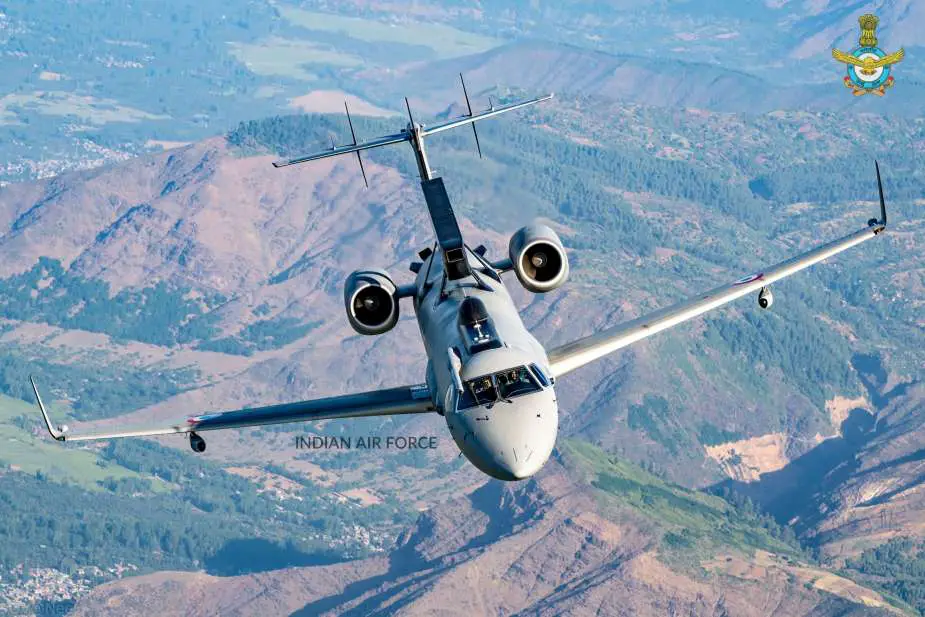Breaking news
India's Defense Ministry to purchase 6 locally-made Netra MK 1A AWACS.
According to BNN on February 13, 2024, the Indian Ministry of Defence is considering the approval of the acquisition of six domestically-developed Netra Mk-1A Airborne Warning and Control System (AWACS) aircraft. This could potentially strengthen the Indian Air Force's (IAF) air defense capabilities, given that the IAF currently operates only five AWACS aircraft, fewer than its regional neighbors Pakistan and China, which possess nine and thirty AWACS respectively.
Follow Air Recognition on Google News at this link
 Currently, the IAF operates three Embraer ERJ 145 aircraft as AEW&CS/AWACS under the Netra MK 1A designation. (Picture source: IAF)
Currently, the IAF operates three Embraer ERJ 145 aircraft as AEW&CS/AWACS under the Netra MK 1A designation. (Picture source: IAF)
The existing disparity poses challenges for India, potentially placing it at a strategic disadvantage in scenarios involving aerial engagements or hypothetical two-front air conflicts. Recognizing this capability gap, the Indian Air Force sees the acquisition of the Netra Mk-1A AWACS as a measure to address this shortfall and potentially improve operational effectiveness.
Currently, the IAF operates three Embraer ERJ 145 aircraft as AEW&CS/AWACS under the Netra MK 1A designation. However, given that the ERJ 145 platform is no longer in production, the Defence Research and Development Organisation (DRDO) and the IAF are actively seeking available units in secondary markets. Additionally, Embraer has proposed the utilization of Praetor 600 aircraft for similar surveillance roles.
The ERJ 145, with its extensive service history spanning over two decades across various airlines worldwide, has proven to be a reliable aircraft in diverse operational environments. Its dimensions include a length of 29.87 m, a wingspan of 20.04 m, and a height of 6.76 m. Powered by two AE 3007-A1E engines, the aircraft exhibits a take-off thrust of 39.67 kilonewtons or 8,917 pounds-force, while its maximum take-off weight is 22,000 kilograms, with a maximum landing weight of 19,300 kilograms and a maximum payload capacity of 5,786 kilograms.
Performance-wise, the ERJ 145 achieves a maximum cruise speed of Mach 0.78 and requires a take-off field length of 2,270 meters, with a landing field length of 1,400 meters. With a service ceiling of 37,000 feet, the aircraft demonstrates a range of 2,873 kilometers, facilitating extensive operational coverage for various missions and tasks.
The decision to prioritize indigenous development comes amidst delays and financial challenges that have affected the IAF's ability to expand its AWACS fleet. Opting for the domestically-developed Netra Mk-1A enables the Ministry of Defence to address operational requirements while supporting India's defense industrial base and achieving cost efficiencies. This approach involves the procurement of second-hand ERJ-145 aircraft for the integration of Netra Mk-1A systems, enhancing IAF capabilities within budgetary constraints.
The Netra project, led by the Defence Research and Development Organisation (DRDO) since 2003, aimed at enhancing the surveillance and tracking capabilities of the Indian Air Force (IAF). Initially, a joint study between the IAF and DRDO assessed the feasibility of developing such a system, leading to governmental approval and assignment of primary responsibility to the Centre for Airborne Systems (CABS).
Various DRDO laboratories played pivotal roles in different aspects of the project, with LRDE focusing on radar array design, DEAL on communication systems, and DARE on self-protection suites. Private sector firms and institutions like the National Aerospace Laboratories (NAL) contributed expertise in aerodynamics and flight modeling.
Central to the DRDO AEW&CS design is the Active Antenna Array Unit (AAAU), featuring two radiating planar arrays assembled back-to-back atop the fuselage to provide 240° coverage. The system is engineered to house various components within minimal dimensions while optimizing mass properties. The AAAU incorporates Indian-designed Transmit-Receive Modules (TRMMs) for efficient radar operation.
In addition to radar capabilities, the AEW&CS boasts mission functionalities including identification friend or foe (IFF), electronic and communication support measures, and datalinks for networking with fighters and ground-based control systems. Equipped with a self-defense suite, air-to-air refueling system, and comprehensive communication capabilities, the aircraft facilitates effective coordination in operational scenarios.























